Good luck Johann.
-

Win a Free Custom Engraved Brass Coin!!!
As a way to introduce our brass coins to the community, we will raffle off a free coin during the month of August. Follow link ABOVE for instructions for entering.
-

PRE-ORDER SHIPS IN SCALE TODAY!
The beloved Ships in Scale Magazine is back and charting a new course for 2026!
Discover new skills, new techniques, and new inspirations in every issue.
NOTE THAT OUR FIRST ISSUE WILL BE JAN/FEB 2026
You are using an out of date browser. It may not display this or other websites correctly.
You should upgrade or use an alternative browser.
You should upgrade or use an alternative browser.
La Créole 1827 by archjofo - Scale 1/48 - French corvette
Hope everything is OK!Hello,
I have to let the model building rest the next time. My metacarpal bone of the right hand is broken. Will probably need surgery, which will be decided tomorrow.
- Joined
- Nov 10, 2019
- Messages
- 469
- Points
- 373

Hi there,
Thank you in advance for the good wishes.
As is well known, I have to pause for a few weeks with the practical implementation in model building.
In this respect, I am currently only dealing with the theory and have worked on the following topic.
I can now write fairly well with the thumb of my right hand and five fingers of my left hand.
Catharpins of the topmast shrouds - Trélingage des haubans de hune
In the course of the rigging for my French corvette, I got to know many different detailed designs as far as the English and French way of rigging was concerned at the beginning of the 19th century.
Based on my research so far, I have come to the conclusion that, especially with English rigs, catharpins have obviously been dispensed with on topmast shrouds and topgallant mast shrouds, or that no need was seen for them. Correspondingly, Klaus Schrage also only describes catharpins of the lower shrouds in "Rundholzer, Tauwerk und Segel" (Rundhölzer, Tauwerk und Segel).
On the other hand, I can state that it seems to have been quite common among the French during the period in question to also provide the topmast shrouds and topgallant mast shrouds with catharpins. This is proven by contemporary models in the Paris museum, as shown in the exemplary compilation in the following picture:
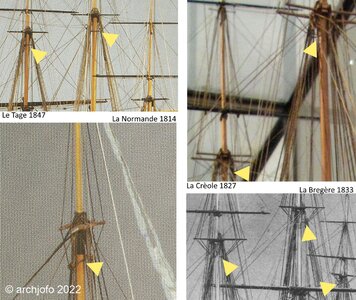
Furthermore, I refer to the explanations in Jean Boudriot's "Le Vaisseau de 74 Canons" Part 3. The following figure from this source:
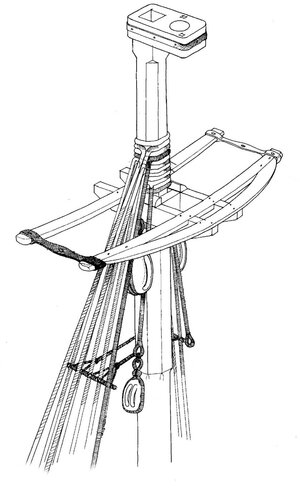
Source: 74er J. Boudriot
As further evidence, I cite relevant contemporary literature, as can be read in a test excerpt below. It is true that this book deals with the rigging of a frigate with 44 guns. But I think that in principle this can also be applied to smaller units such as corvettes. This in turn corresponds to the corresponding representations on the contemporary models.
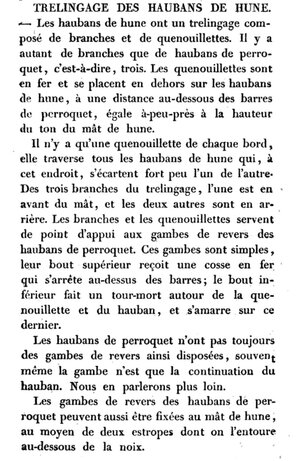
Source: Manual du jeune marin - page 121 - Louis-Stanislas Baudin · 1828
So that's how I'm going to do it on my corvette.
Up soon ...
Thank you in advance for the good wishes.
As is well known, I have to pause for a few weeks with the practical implementation in model building.
In this respect, I am currently only dealing with the theory and have worked on the following topic.
I can now write fairly well with the thumb of my right hand and five fingers of my left hand.
Catharpins of the topmast shrouds - Trélingage des haubans de hune
In the course of the rigging for my French corvette, I got to know many different detailed designs as far as the English and French way of rigging was concerned at the beginning of the 19th century.
Based on my research so far, I have come to the conclusion that, especially with English rigs, catharpins have obviously been dispensed with on topmast shrouds and topgallant mast shrouds, or that no need was seen for them. Correspondingly, Klaus Schrage also only describes catharpins of the lower shrouds in "Rundholzer, Tauwerk und Segel" (Rundhölzer, Tauwerk und Segel).
On the other hand, I can state that it seems to have been quite common among the French during the period in question to also provide the topmast shrouds and topgallant mast shrouds with catharpins. This is proven by contemporary models in the Paris museum, as shown in the exemplary compilation in the following picture:

Furthermore, I refer to the explanations in Jean Boudriot's "Le Vaisseau de 74 Canons" Part 3. The following figure from this source:

Source: 74er J. Boudriot
As further evidence, I cite relevant contemporary literature, as can be read in a test excerpt below. It is true that this book deals with the rigging of a frigate with 44 guns. But I think that in principle this can also be applied to smaller units such as corvettes. This in turn corresponds to the corresponding representations on the contemporary models.

Source: Manual du jeune marin - page 121 - Louis-Stanislas Baudin · 1828
So that's how I'm going to do it on my corvette.
Up soon ...
- Joined
- Nov 10, 2019
- Messages
- 469
- Points
- 373

Hello,
after a short creative break ... ... we continue here again:
Continuation: Ratlines for the topmast shrouds - Enflechures
With the addition of the ratlines for the topmast shrouds, it was necessary to clarify how the futtock staves are to be made here. In contrast to the more massive futtock staves of the lower shrouds, made of served brass rods, I used a rope with ø 0.35 mm for the topmast shrouds, which was soaked with super glue before serving.
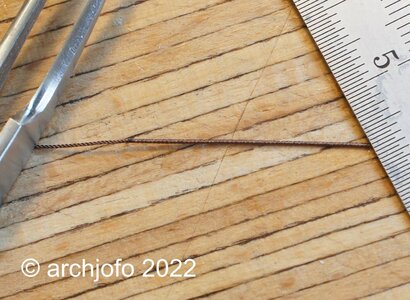
After fixing the futtock stave, I could attach the last ratlines of the port side main topmast shrouds.

So the chapter -ratlines for the main topmast shrouds- is done:
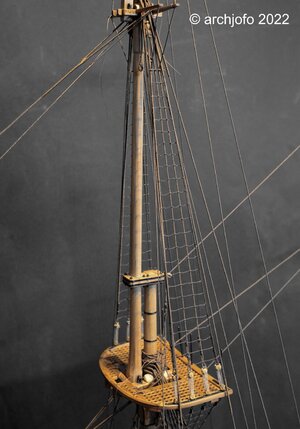
Soon I will continue with the ratlines for the fore topmast shrouds to finally close the chapter -ratlines- for this model.
To be continued ..
after a short creative break ... ... we continue here again:
Continuation: Ratlines for the topmast shrouds - Enflechures
With the addition of the ratlines for the topmast shrouds, it was necessary to clarify how the futtock staves are to be made here. In contrast to the more massive futtock staves of the lower shrouds, made of served brass rods, I used a rope with ø 0.35 mm for the topmast shrouds, which was soaked with super glue before serving.

After fixing the futtock stave, I could attach the last ratlines of the port side main topmast shrouds.

So the chapter -ratlines for the main topmast shrouds- is done:

Soon I will continue with the ratlines for the fore topmast shrouds to finally close the chapter -ratlines- for this model.
To be continued ..
Hello Johann nice to know that you can work on La Creole again, I take it that your hand is doing better again. Great performance with the ratlines.
Good to see, that you hand is back working on the rigging - good to see, that you are well and recovered
- Joined
- Nov 10, 2019
- Messages
- 469
- Points
- 373

Many thanks to you,
also for the interest in my work,
especially since I can't deliver anything new.
I have already started with the ratlines of the topmast shrouds. In this respect, I already see a silver lining on the horizon ...
Yes, the hand has healed well so far. However, due to the long immobilization with splint the fingers are a bit rusty. But it is getting better from day to day.
also for the interest in my work,
especially since I can't deliver anything new.
I have already started with the ratlines of the topmast shrouds. In this respect, I already see a silver lining on the horizon ...
Yes, the hand has healed well so far. However, due to the long immobilization with splint the fingers are a bit rusty. But it is getting better from day to day.
Hello Johann, we can already hear that your fracture has healed well. And your fingers will soon get going again.Many thanks to you,
also for the interest in my work,
especially since I can't deliver anything new.
I have already started with the ratlines of the topmast shrouds. In this respect, I already see a silver lining on the horizon ...
Yes, the hand has healed well so far. However, due to the long immobilization with splint the fingers are a bit rusty. But it is getting better from day to day.
Hallo Johann alias @archjofoHello,
up to now I have also been represented in other forums. Due to the fact that many excellent model builders also present their building reports here, I have decided to show my building report on the model of the La Créole here in the future.
At the end of this thread I will show you a series of pictures from the beginning to the present state of construction.
At the moment I am still working on the standing rigging, especially the backstays.
View attachment 236053View attachment 236054View attachment 236055
Here are a few brief facts about the ship for those who don't know her yet:
The La Créole was a 24-gun corvette of the French Navy. The corvette carried 4 x 18 pdr guns and 20 x 30 pdr carronades.
Her plans were drawn by P. M. Leroux in 1827. The launching took place in Cherbourg in May 1829.
The ship took part in the French invasion of Mexico in 1838, notably the bombardment of San Juan de Ulloa before the French troops took the city of Veracruz.
There is a beautiful model of the shipyard on display at the Musée national de la Marine in Paris, with many photos in Jean Boudriot's book (in French).
For the construction of my model of the corvette I mainly use the following sources:
Jean Boudriot - Historique de la corvette 1650-1850: La Créole, 1827
In this forum there is a planset review: LINK.
Finally, a few pictures from the beginning to the present state of construction:
View attachment 236064 View attachment 236067 View attachment 236071View attachment 236073View attachment 236074View attachment 236075View attachment 236076View attachment 236078View attachment 236079View attachment 236080View attachment 236081View attachment 236082View attachment 236083View attachment 236084View attachment 236085View attachment 236086View attachment 236087View attachment 236088 View attachment 236144
To be continued ...
we wish you all the BEST and a HAPPY BIRTHDAY
Enjoy your special day

I hope you hand is getting better and better
BTW: Du bist in guter Gesellschaft, da heute auch Bonden und Alexander Foxtrott Geburtstag feiern
Last edited:
Happy Birthday
All the best to your birthday also from me, joy, satisfaction ans above all health.
I'll add my birthday wishes to those shared by our colleagues. I hope you have a great day Johann.
Happy birthday Johann and enjoy the day! 
Best regards
Thomas

Best regards
Thomas
DOĞUM GÜNÜN KUTLU OLSUN ,SAĞLIKLI YAŞLAR DİLİYORUM
Hoch soll er leben!
Hoch soll er leben!
Dreimal hoch!
Hoch soll er leben!
Dreimal hoch!







 wish you all the best and happiness
wish you all the best and happiness
